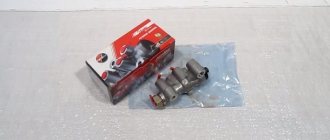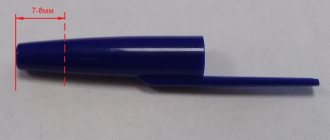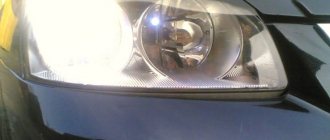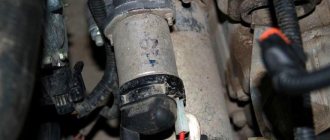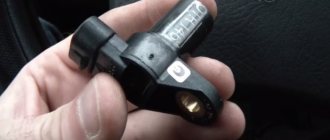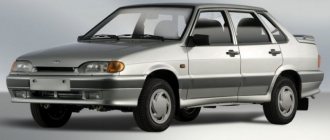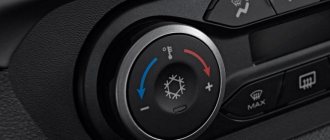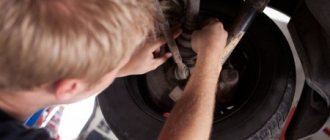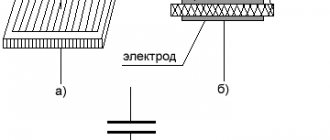Skidding is the most dangerous situation on the road. It is this that most often becomes the cause of driving into the oncoming lane and a head-on collision. Therefore, every driver must be able to properly deal with skidding. And we will describe in detail how to do this below.
It is worth warning in advance that the article is very voluminous and contains a lot of video materials on the topic. Therefore, we recommend that you arm yourself with a mug of coffee or tea, get comfortable, and carefully study the information presented below.
Sharp braking
If, when driving in rain or snow, the driver applies sharp braking, then, even despite the presence of ABS, the wheels lose traction with the slippery road surface. This provokes the drift of the rear axle of the car.
When braking sharply, a skid can occur even on a dry road. Therefore, such action is allowed only in extreme cases. Unnecessarily, resorting to sudden braking (and especially in rain or winter) is prohibited.
Why it is not recommended to skid
Slipping is an action that affects not only new car enthusiasts, but also experienced car owners. Everyone is familiar with the situation when you are in a hurry, flying at full speed to a meeting or home in the evening, you do not notice a snowdrift and drive into it.
Read
Diagnostics, repair and replacement of automatic transmission torque converter
This makes you angry and you start rocking the car, just like you do with a manual car. Does everyone know this feeling? So, under no circumstances should you do automatic swinging.
Slipping is fraught with overloads on the planetary gearbox and torque converter of the machine. The following happens when you try to check out:
- The oil in the bagel overheats over 100 degrees in the machine. It cannot act as a protector and lubricant when overheated.
- Due to the constant shifting of gears from “D” to “R”, clutches and steel discs with teeth rub against each other intensely.
- Overheating affects all automatic transmission systems.
- As a result, the car owner receives an overheated automatic machine with a shortened lifespan.
Attention! After prolonged slipping, it is necessary to immediately change the lubricant in order to somehow smooth out the car owner’s mistakes.
Taking a turn at high speed
Any experienced driver knows that before turning, you must slow down. Moreover, it does not depend on whether it is icy, wet or dry. Entering a corner at high speed is the most common cause of skidding. Most often, such a skid ends with driving into the oncoming lane or driving into a ditch.
Reducing speed when turning minimizes the risk of skidding. You must also remember that you should not resort to sudden braking when turning. When it rains or is icy, the speed should be reduced to 10-15 km/h less than on a dry road.
Is it possible to feel in advance that the car has gone into a skid?
It is quite simple to provoke a skid - just a sudden movement of the steering wheel or pressing the brake pedal. But not everyone is able to feel it at the initial stage. Especially if it concerns a person who has just received a driver’s license.
The feeling of skidding comes only with experience. Driving the same car for a long time, the driver begins to feel its dimensions and predicts the car’s behavior in advance. Even a slight skid begins to be clearly felt. And the driver takes measures in advance to correct the situation and take everything under control.
You can feel the skid in advance. But, as mentioned earlier, such instinct comes with time and driving experience. Moreover, for this the driver must sit correctly behind the wheel. We discussed the correct fit in detail in this article (we recommend reading it).
Features of all-wheel drive vehicles
All-wheel drive: traction distribution schemes on all wheels
The all-wheel drive vehicle flaunts clever features that attract the attention of consumers:
- has the most efficient acceleration dynamics;
- tends to overcome difficult off-road areas;
- able to easily climb ice slides.
However, not every all-wheel drive transmission is capable of efficiently implementing these characteristics. However, even the full implementation of immediate tasks does not occur in an uncompromising manner. Much depends on the layout of the all-wheel drive :
- constant;
- connected by means of automation;
- manually connected.
Permanent all-wheel drive in winter: features and difficulties
The full all-wheel drive layout ensures that power is constantly circulated between the engine and the front and rear axles. The main structural unit of the system is a transfer case , which distributes traction between two cross-axle differentials. The node includes :
- center differential;
- a locking device that provides a rigid connection between the front and rear axles (viscous coupling, friction clutch, self-locking differential);
- a chain transmission through which torque is supplied to the front axle shaft.
It is the full-fledged all-wheel drive that is an indispensable assistant in winter : power is supplied to all 4 wheels continuously both on asphalt and off-road, and the instantly activated lock allows you to confidently storm the snow-covered “intersection”.
The classic emphasis on the cross-country ability of a permanent all-wheel drive vehicle is made to the detriment of other qualities:
- large mass;
- obviously increased fuel consumption;
- the complexity of the design implementation, significantly increasing the cost of the option.
Universal technological solution: plug-in all-wheel drive
A hybrid alternative to a permanent 4x4 distribution scheme - front-wheel drive with an electronically connected rear axle on demand . The transmission layout is a complicated version of the “front-wheel drive”:
- The front axle differential is traditionally connected to the gearbox;
- primitive transfer case: bevel gear that transmits torque from the front axle to the cardan drive;
- unit connecting the rear axle: viscous coupling or friction unit.
The electronic continuously variable power distribution is tempting:
- relatively low cost of the product;
- small dimensions and weight of components;
- a slight increase in fuel consumption compared to the front-wheel drive version.
However, the solution is quite a compromise:
- on off-road and snowy areas, a blocked clutch is prone to rapid overheating and failure;
- on a normal highway, the car is practically in front-wheel drive mode (a small amount of power is transferred to the rear axle - up to 10-20%);
- full use of the rear axle is only possible when the front wheels slip or start.
It is worth noting that it is very difficult to prevent skidding with all-wheel drive of this arrangement . A sudden transmission of torque to the rear wheels, which occurs when the front axle slips, will require precious actions from the driver.
Conservative approach: manual all-wheel drive
By eliminating the differential from the full-fledged all-wheel drive system and replacing the electronic locking with the possibility of manual connection through the “transfer case” of the front axle, you can get a primitive small-sized mechanical all-wheel drive system. The design inherent to purely off-road vehicles has the following features :
- resistance to large mechanical loads;
- in the activated state, a 50/50 ratio is ensured;
- when turned on, reliable mechanics can ruin the transmission on the asphalt;
- switching occurs with the vehicle stationary.
Rear axle demolition
Rear axle drift, or oversteer, is manifested in the loss of traction with the road surface of the rear wheels of the car. The car begins to “carry” sideways along the road. This is the most common and familiar type of skid to many drivers.
In such a situation, the driver needs to take his feet off the gas and brake pedals and turn the steering wheel in the direction of the skid. If the car is front-wheel drive, then, on the contrary, you need to carefully apply the gas.
Such a skid most often occurs due to the fact that the main weight of the car is shifted to the front axle, while the rear axle is unloaded. Accordingly, the rear wheels have less traction. This happens mainly during sudden braking.
Traction distribution schemes for all wheels
This type of transport has the following advantages:
- the most efficient acceleration dynamics in terms of speed characteristics and gasoline consumption;
- the ability to easily overcome serious obstacles that are impassable for other types of transport;
- good grip when climbing on icy road surfaces.
But still, all-wheel drive does not always behave well in a skid. It's better to use a persistent layout. A compromise option is the ability to manually control the transmission. When the drive is connected automatically, if it starts to slide, this can lead to an even greater skid and even overturning of the vehicle. So pilots of such cars should be as careful as possible.
Front axle demolition
Front axle drift, or understeer, is the loss of traction on the vehicle's front wheels. In such a situation, the car simply does not “fit” into the turn and “flies” into a ditch or onto the sidewalk. Such a skid is very dangerous, since there may be pedestrians on the sidewalk who will not have time to quickly react to the danger.
Front axle drift occurs when the driver enters a turn at high speed. In such a situation, there is no need to try to turn the steering wheel even more, press the brake or add more gas. The pedals must be released (especially on rear-wheel drive or all-wheel drive vehicles).
How to avoid skidding in winter: car preparation
The best way to avoid a skid is to not get into one. Therefore, proper preparation of the car and instructing the driver are the main conditions for avoiding dangerous situations on the road.
To begin with, it is important to understand that there is a drift in the physical sense of considering this concept. A car skids because its rear axle begins to move faster than the front. When hitting a bump, a puddle or an icy area, as well as when driving the steering wheel carelessly, the front axle slows down, while the rear axle continues to move at the initial speed or even accelerates if we are talking about a rear-wheel drive car. A torque arises that tends to push the rear axle of the car forward, and throw the front, lagging behind, back. Due to the difference in axle speeds, the car begins to turn.
Let's consider preparatory procedures that will give the car more stability on slippery roads.
- Installation of high-quality winter tires
Tires are responsible for the grip of the wheels on the road. The better the tires, the higher the coefficient of adhesion to the road and the more difficult it is for the car to skid. In order not to worry about safety, you should give preference to Yokohama or Cordiant winter tires.
- Brake system inspection
The difference in braking forces between wheels, especially those located on the same axis, creates a force moment that tends to turn the car during braking. Therefore, before the onset of cold weather, check the serviceability of the brake system (wear of pads, discs and drums, mobility of calipers, condition of the fluid in the expansion tank, uniformity of braking force). Preventatively lubricate the caliper guides.
- Checking the functionality of the ABS and ESP systems
Particular attention should be paid to the exchange rate stability system (ESP). After all, in a modern car it is she who is responsible for automating the recovery from a skid. The ESP automatic system will gently slow down the forward axle of the car, thereby equalizing the speed of the wheels and normalizing the uniformity of movement of all points of contact of the car with the road. The ABS system prevents the wheels from skidding, which also has a beneficial effect on the vehicle's stability on slippery roads. Check the car's ECU for errors in these systems and, if found, eliminate the cause.
The main rule that allows you to avoid skidding in winter is not to apply sudden force to the car controls. You need to rotate the steering wheel slowly and sedately, brake in advance and accelerate smoothly, try to choose a safe speed and not play checkers.
Wheel lock
Wheel locking occurs when the driver sharply presses the brake pedal. At high speeds, the wheels stop rotating, and the car, by inertia (under its own weight), continues to move (slides along the road surface). This also causes skidding.
The actions in this case are simple - release the brake pedal so that the wheels resume rotation and traction returns. After which you can try to brake again, but pressing the brake smoothly and without sudden movements of the steering wheel.
Subscribe to our Telegram channel
Correct fit
Good driving instructors often draw the attention of their students to the correct seating position. It is very important for comfortable driving. And the point here is not even about convenience, the point here is how sensitively you can track the behavior of your car on the road and react in time to its changes. When driving, do not go to extremes.
You shouldn’t sit clutching the steering wheel, since such excessive tension will lead to rapid fatigue and dissipation of attention, but you shouldn’t fall into a reclining position, imposingly turning the steering wheel with one finger.
A complete lack of concentration on the road situation is unacceptable. When driving, visibility is of great importance, and, in addition to it, the ability to reach any buttons and control levers at any time. A skid is usually the result of human error. The more severe the error, the greater the skidding angle you will get as a result. Of course, it will be easier for a driver who has extensive driving experience to cope with a skid. However, there is a way out for beginners too. You can take an additional lesson to improve your skills. Such training under the guidance of an experienced instructor will significantly increase your confidence on the winter road and protect you from unpleasant incidents.
